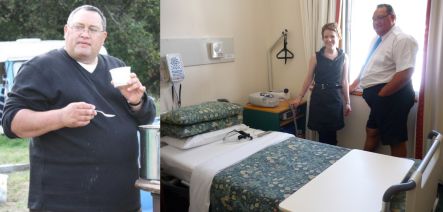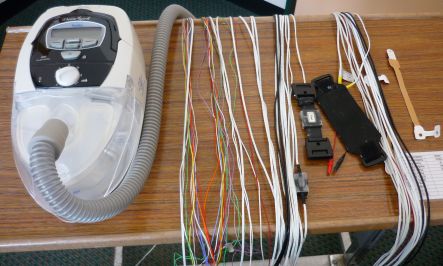
Maui Stuart before his diagnosis of sleep apnoea (left), and after (right) in the room where he had the overnight sleep study with Jessie Bakker (images: Maui Stuart and Ruth Beran)
In this two-part story, Ruth Beran meets Maui Stuart who was recently diagnosed with sleep apnoea after an overnight sleep study at WellSleep, a sleep investigation centre based at Wellington's Bowen Hospital.
Jessie Bakker from the University of Otago, Wellington who worked at WellSleep explains what sleep apnoea is, how it is diagnosed, what happens during a sleep study, and demonstrates the gold standard treatment - a continuous positive airways pressure (CPAP) machine.

A CPAP machine and leads used in overnight sleep studies(image: Ruth Beran)
Jessie Bakker recently led a study analysing why some people in the community are less likely to continue with CPAP treatment. The first part of the study was based on a questionnaire of 127 patients living in the Greater Wellington area, and found that ethnicity did not independently predict compliance with CPAP after measures like socioeconomic deprivation and education were factored in.
The second part of the study involved three focus groups where eight New Zealand Europeans, five Maori and five Pacific patients, and while discussions did touch on culturally-specific aspects, all groups discussed common problems like financial barriers to CPAP use, feeling overwhelmed with the CPAP educational material, and the importance of role models.
Maui Stuart benefited from the discussion group, and has been changing his life ever since he was diagnosed with sleep apnoea. He has continued with CPAP treatment, has changed his diet, and is now doing regular exercise. He has lost over 25 kilograms so far, and his goal is to swim the Cook Strait.

